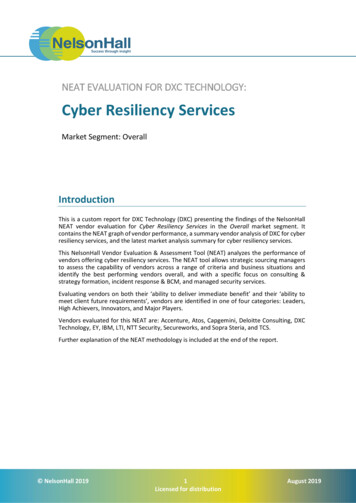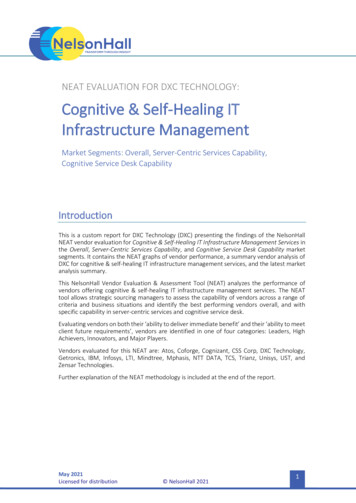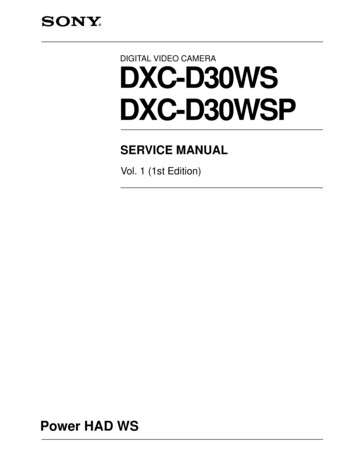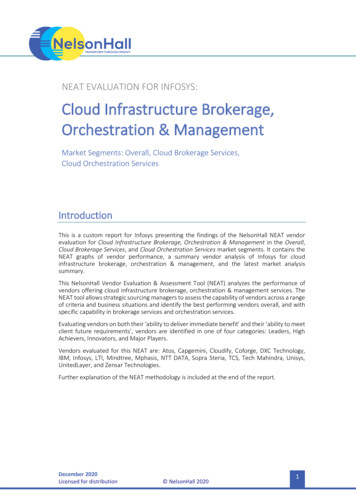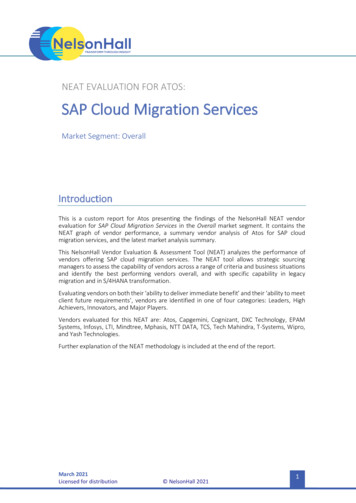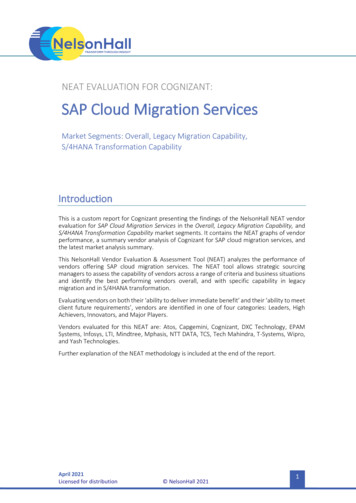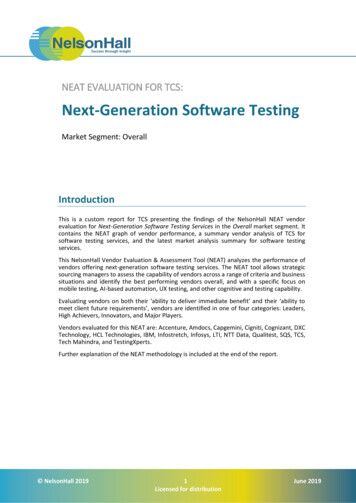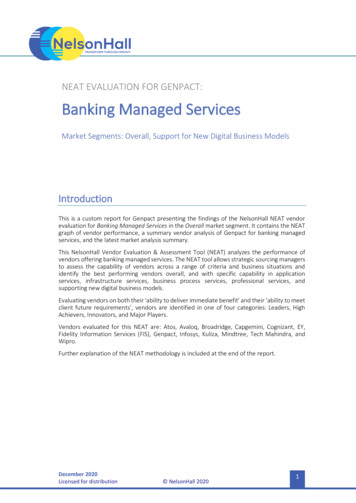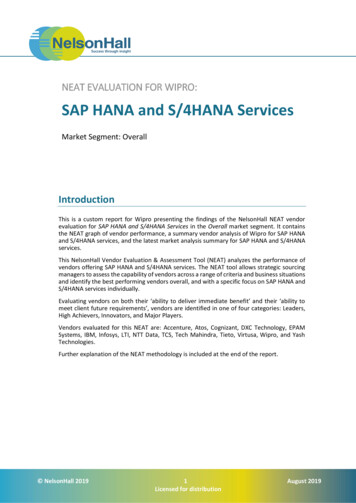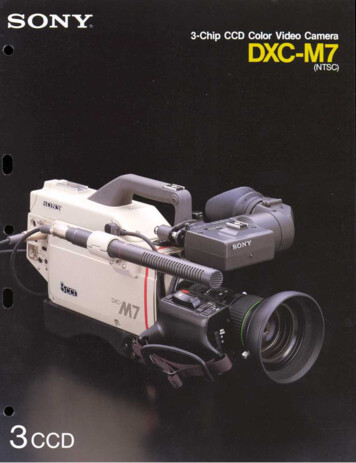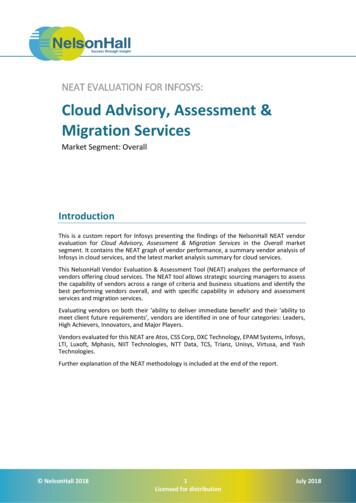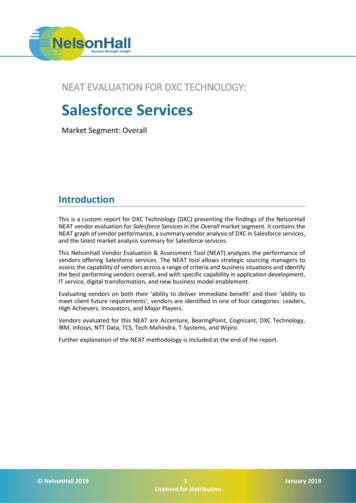
Transcription
NEAT EVALUATION FOR DXC TECHNOLOGY:Salesforce ServicesMarket Segment: OverallIntroductionThis is a custom report for DXC Technology (DXC) presenting the findings of the NelsonHallNEAT vendor evaluation for Salesforce Services in the Overall market segment. It contains theNEAT graph of vendor performance, a summary vendor analysis of DXC in Salesforce services,and the latest market analysis summary for Salesforce services.This NelsonHall Vendor Evaluation & Assessment Tool (NEAT) analyzes the performance ofvendors offering Salesforce services. The NEAT tool allows strategic sourcing managers toassess the capability of vendors across a range of criteria and business situations and identifythe best performing vendors overall, and with specific capability in application development,IT service, digital transformation, and new business model enablement.Evaluating vendors on both their ‘ability to deliver immediate benefit’ and their ‘ability tomeet client future requirements’, vendors are identified in one of four categories: Leaders,High Achievers, Innovators, and Major Players.Vendors evaluated for this NEAT are Accenture, BearingPoint, Cognizant, DXC Technology,IBM, Infosys, NTT Data, TCS, Tech Mahindra, T-Systems, and Wipro.Further explanation of the NEAT methodology is included at the end of the report. NelsonHall 20191Licensed for distributionJanuary 2019
NEAT Evaluation for DXC Technology: Salesforce ServicesNEAT Evaluation: Salesforce Services (Overall)NelsonHall has identified DXC as a Leader in the Overall market segment, as shown in theNEAT graph. This market segment reflects DXC’s overall ability to meet future clientrequirements as well as delivering immediate benefits to Salesforce services clients.Leaders are vendors that exhibit both a high ability relative to their peers to deliverimmediate benefit and a high capability relative to their peers to meet client futurerequirements.Buy-side organizations can access the Salesforce Services NEAT tool (Overall) here. NelsonHall 20192Licensed for distributionJanuary 2019
NEAT Evaluation for DXC Technology: Salesforce ServicesVendor Analysis Summary for DXC TechnologyOverviewDXC has its Salesforce (SFDC) capabilities within its Enterprise and Cloud Apps serviceline. The company has positioned its capabilities between, on one side, the large-scalevendors with a consulting background (e.g., Accenture, Deloitte, and PwC), and on the otherside the India-headquartered firms. DXC intends to, therefore, combine consultingcapabilities, onshore presence, and also a global delivery network.DXC is focusing on post-implementation services, targeting in its client base, organizationsthat have completed their first Cloud implementation (mostly CRM/Sales Cloud) and need tofine-tune the implementation, focusing on business process standardization, and using newfunctionality brought by SFDC.The company is balancing the development of its workforce and is somewhat shifting itshiring effort onshore. For instance, in the U.S., DXC wants to rebalance its onshore/onsitepresence from 30% of all personnel to 40%.Also, a key element in the SFDC strategy of DXC is to bring "blended services", offeringsinvolving DXC's nine service lines.An example of this blended service approach is around digital transformation, and inparticular around UX; looking at re-engineering business processes of the clients, and takingwhere possible a consulting-led approach. This service involves several units within DXC,including DXC Consulting, and its SFDC capabilities.Another example of this blended service approach is DXC working with the BPS service line,to provide joint customer management services (i.e., call center services) along with theunderlying technology (i.e., Service Cloud).DXC stresses its partnership with SFDC is multi-tiered with DXC being an IT services partner,a business process partner (see paragraph above), and also an ISV partner (for itsOmnichannel for Insurance software product). DXC is also a significant user of SFDCapplications and has 3k personnel using Sales Cloud internally.Finally, DXC highlights that acquisitions are part of its SFDC development strategy. Thecompany acquired in October 2017 the shared service center, LLX Global Business Services,of a luxury holding, Jab Luxury based in Switzerland. The shared service center LLX had 90employees, mostly in Switzerland, and also in the U.K. and APAC. It provided F&A BPS,Salesforce Commerce Cloud, and creative design services.DXC Technology has 50 SFDC clients.In 2018 onwards, DXC is focusing on three main offerings: Health checks. See below the Health checks sub-section Lightning Experience migration. See below the Lightning Experience migration subsection Commerce Cloud. See below the Commerce Cloud sub-section Financial Services Cloud. Financial Services Cloud is a priority for DXC, largely because ofits background in software products for the banking and insurance industries. NelsonHall 20193Licensed for distributionJanuary 2019
NEAT Evaluation for DXC Technology: Salesforce ServicesDXC Omnichannel for Insurance is a recent AppExchange software product, based onFinancial Services Cloud. Omnichannel targets the P&C insurance industry. Its featuresinclude A customer self-service portal for brokers and agents, and also for call center agents A customer journey approach Integration with DXC's GraphTalk AIA, and with Guidewire.DXC has released Omnichannel for Insurance in Europe and Japan and already has one client(see Target Markets section). The company will release the product in North America in H22018.FinancialsNelsonHall estimates DXC’s SFDC services revenues to be: 2017: 30m 2018: 40m.Strengths Service portfolio: DXC Technology has structured and well-articulated its serviceportfolio around consulting, systems integration, and post-implementation services. Ithas in consulting, entry level packaged offerings, and specific offerings in systemsintegration (health checks, Lightning migration) IP: DXC is investing selectively in SFDC-related software products. Its most significantproduct is DXC Omnichannel for Insurance The company is one of the few SFDC partners to develop a Service Cloud-based BPS Delivery: DXC has a balanced onshore and offshore delivery capability thataccommodates the different country needs in which it operates.Challenges DXC lacks IP both software (blueprints and reference architectures) and hard IPs(development workbench, a SFDC-specific project management tool, and Lightning boltsfor verticalized offerings) DXC needs to scale up its SFDC practice size and be able to fund the development of itsportfolio and delivery engine. NelsonHall 20194Licensed for distributionJanuary 2019
NEAT Evaluation for DXC Technology: Salesforce ServicesStrategic DirectionDXC's SFDC practice is the smallest practice within ECA, which also includes practices aroundSAP, Oracle, ServiceNow, Microsoft. DXC has therefore big ambitions to grow its SFDCpractice both organically and inorganically. DXC hints that it will make acquisitions initiallyaround Commerce Cloud and complement its acquisition of LLX Global Business Services.Service portfolio is one of the main organic growth priorities. DXC wants to create and sellmore reusable services, in the form of vertical offerings, targeting five industries where DXCalready has IPs: Banking Insurance Healthcare Life science Travel and transportation.The company has hired major consultancy firms to test new verticalized offerings andsoftware products and make sure they are priced competitively. Also, DXC is also focusing onspecific offerings such as Classic to Lightning Experience migration.Blended services are another priority: DXC's SFDC practice is working with DXC's BPS unit.DXC BPS is a sizeable organization within DXC with a headcount of 15k and operating in twoareas F&A and CMS/CX. At a high level, the strategy of DXC BPS is to combined processingservices and technology usage, initially looking at deploying RPA and AI, and also using SFDC'sService Cloud for its CMS/CX operations. The joint SFDC and BPS offering is called CX as aService and includes: Service Cloud Einstein for providing suggestions to contact center agents, and next-best actions forselling additional products and services to the calling customer Integration with the Avaya-based omnichannel and communication services. DXC in itsroadmap will also include communication technology from Amazon.As part of this service portfolio, DXC would own the relationship with the client, and be areseller of SFDC's products.OutlookDXC has proved that in spite of its intense history, under CEO Mike Lawrie, it could restructureits business and achieve cost savings, while, in parallel, investing into offerings, and makingacquisitions into digital capabilities. The company has done this with its focus on standardofferings, while building up its ServiceNow and Microsoft Dynamics CRM capabilities.DXC is now saying it wants to scale up its SFDC capabilities and that acquisitions will be partof the journey. This is a credible claim. NelsonHall is expecting acquisitions around CommerceCloud. NelsonHall 20195Licensed for distributionJanuary 2019
NEAT Evaluation for DXC Technology: Salesforce ServicesSalesforce Services Market SummaryBuy-Side DynamicsFour main client profiles dominate the market: Digitally-driven organizations, i.e. organizations focused on rejuvenating their CRM,marketing, e-commerce, and call center applications and selecting Salesforce as apartner that will bring digital functionality and an improved UX. Digitally-drivenorganization are the largest client profile and represent 65% of Salesforce servicespending Salesforce-centric organizations, i.e. organizations that need to refresh their agingapplications and select Salesforce’ Cloud as a starting point for developing their customapplications. This client segment accounts for 10% of spending IT-focused organizations ( 20% of spending), i.e. organizations that are considering theirSalesforce investment as an IT project, to simplify and rationalize their IT, and loweroperating costs ‘New model eager’ firms, e.g. organizations that are engaged in bundled IT services andBPS contracts. This is a small (5% of spending) but rising client segment.Market Size & GrowthThe Salesforce services market is a dynamic market. Current spending is limited, to 5.6bn.But growth potential is very high (2017-2022 CAGR of 17%).There are two main drivers for the growth of the Salesforce services. At the core is the successof Salesforce, which has emerged from a niche (sales force automation) and has become theleader in front-office software (including CRM, e-commerce, contact center, and marketingapplications) and also a platform on which clients are creating their software. Also, Salesforceis a high-growth story with its service ecosystem growing as fast.North America is the largest geography for Salesforce services. By far, with spending in 2022reaching 8.3bn, three times as much as in EMEA.Systems integration is the largest area of spending.Sales Cloud (the former CRM product) currently is the largest service market, with 2.0bn inspending in 2017. Service Cloud (contact center software) is the second largest, with 1.7bnin related service spending.Salesforce has indicated that it would focus its vertical efforts on six large industries: financialservices, manufacturing, communication & media, healthcare, and life science, retail, andpublic sector. These six industries represent 80% of the subscription revenues of Salesforceand its largest service opportunity.Currently, Salesforce project delivery is more onsite than for SAP/ERP projects: Clients are not as experienced in conducting Salesforce projects as in ERP ones The nature of clients differs, with marketing and business units often taking a prime roleover IT departments. These new clients have less experience than IT departments inconducting offshore-centric projects. NelsonHall 20196Licensed for distributionJanuary 2019
NEAT Evaluation for DXC Technology: Salesforce ServicesWhile the U.S. and U.K. accept some level of offshoring for their business analytics, andbusiness process needs, Continental Europe is much more onsite-centric.Success FactorsKey selection criteria for selecting an IoT services vendor by client segment include: Digitally-driven organizations select their vendors based on their Salesforce productknowledge both from a technical and functional point of view. They will use thetemplates and reference architectures that their vendors bring along with technicalaccelerators that are Salesforce-specific, e.g. Siebel to Salesforce migration or projectmanagement tools Salesforce-centric organizations are using Salesforce applications as the platform forfurther development. Their vendors of choice need to demonstrate Salesforce productcapabilities, a solid partnership with Salesforce, technical capabilities, and the ability toconduct digital projects in an agile context IT-focused organizations select vendors based on their track record in applicationmanagement and their ability to drive IT cost savings. They need their vendor to gobeyond application management, and provide the full range of post-implementationservices, to make use of additional functionality brought by Salesforce, and also adoptmajor upgrades such as Lightning Experience ‘New model eager’ firms require from their vendor, in addition to Salesforce productexpertise, the ability to provide new or bundled offerings, e.g., contact center servicescombined with Service Cloud.OutlookThe Salesforce services market will continue to grow fast. It will reach 12.4bn by 2022,growing at a 17% CAGR. Growth will be primarily by the expansion of Salesforce’s productline, and its stated objective to reach revenues of 20bn- 22bn by FY22.North will remain the largest market globally. However, growth in North America will besomewhat lower than in other geographies, largely because of Salesforce’s focus on growingits software subscriptions outside of its core market (CRM in North America) to othergeographies and new product.Systems integration will remain the largest area of spending. Consulting spending growth willgradually slow down as organizations become more experienced in implementing Salesforceproducts and require less consulting guidance. Demand for application management andpost-implementation services will increase gradually.From a product perspective, the service ecosystem will change, and Customer SuccessPlatform and other products will become, by 2022, larger than both Sales and Service Clouds.This is consistent with the strategy of Salesforce to drive the usage of the Platform tools tocreate new applications and products based on Salesforce’s products.Salesforce is focusing on six core industries, and the service opportunities will reflect thefocus of Salesforce: the growth of services spending will largely depend on the verticalizationstrategy of Salesforce and its commercial efforts. NelsonHall believes that Salesforce will aimto deepen its vertical products, in financial services and U.S. healthcare, rather than spreadthinly over too many verticals. NelsonHall 20197Licensed for distributionJanuary 2019
NEAT Evaluation for DXC Technology: Salesforce ServicesDelivery will change: the level of offshoring will increase in both the U.S./U.K. and ContinentalEurope, as organizations become more experience with Salesforce projects. Several roles,such as consulting and product design, will, however, remain onsite-centric. NelsonHall 20198Licensed for distributionJanuary 2019
NEAT Evaluation for DXC Technology: Salesforce ServicesNEAT Methodology for Salesforce ServicesNelsonHall’s (vendor) Evaluation & Assessment Tool (NEAT) is a method by which strategicsourcing managers can evaluate outsourcing vendors and is part of NelsonHall's Speed-toSource initiative. The NEAT tool sits at the front-end of the vendor screening process andconsists of a two-axis model: assessing vendors against their ‘ability to deliver immediatebenefit’ to buy-side organizations and their ‘ability to meet client future requirements’. Thelatter axis is a pragmatic assessment of the vendor's ability to take clients on an innovationjourney over the lifetime of their next contract.The ‘ability to deliver immediate benefit’ assessment is based on the criteria shown in Exhibit1, typically reflecting the current maturity of the vendor’s offerings, delivery capability,benefits achievement on behalf of clients, and customer presence.The ‘ability to meet client future requirements’ assessment is based on the criteria shown inExhibit 2, and provides a measure of the extent to which the supplier is well-positioned tosupport the customer journey over the life of a contract. This includes criteria such as thelevel of partnership established with clients, the mechanisms in place to drive innovation, thelevel of investment in the service, and the financial stability of the vendor.The vendors covered in NelsonHall NEAT projects are typically the leaders in their fields.However, within this context, the categorization of vendors within NelsonHall NEAT projectsis as follows: Leaders: vendors that exhibit both a high ability relative to their peers to deliverimmediate benefit and a high capability relative to their peers to meet client futurerequirements High Achievers: vendors that exhibit a high ability relative to their peers to deliverimmediate benefit but have scope to enhance their ability to meet client futurerequirements Innovators: vendors that exhibit a high capability relative to their peers to meet clientfuture requirements but have scope to enhance their ability to deliver immediate benefit Major Players: other significant vendors for this service type.The scoring of the vendors is based on a combination of analyst assessment, principallyaround measurements of the ability to deliver immediate benefit; and feedback frominterviewing of vendor clients, principally in support of measurements of levels of partnershipand ability to meet future client requirements. NelsonHall 20199Licensed for distributionJanuary 2019
NEAT Evaluation for DXC Technology: Salesforce ServicesExhibit 1‘Ability to deliver immediate benefit’: Assessment criteriaAssessment CategoryOfferingsDeliveryPresenceBenefits Achieved NelsonHall 2019Assessment CriteriaAdvisory & consulting servicesBreadth of implementation servicesSpecialized implementation servicesPost-implementation servicesTesting servicesNext-gen services: AINest-gen services: BPaaSStrength of partnershipU.S.U.K.Continental EuropeIndiaIndustry solutionsMethodologies, IP & acceleratorsGloballyU.S.EMEARoWLevel of cost savingsTimely implementationImplementation benefitsImproved access to next-gen SFDC capabilitiesIncreased speed-to-marketIncrease in end-user/business satisfactionReduced turnaround time for customers/operationsCorrelation between vendor fees and objectives achievedPerception of value for money10Licensed for distributionJanuary 2019
NEAT Evaluation for DXC Technology: Salesforce ServicesExhibit 2‘Ability to meet client future requirements’: Assessment criteriaAssessment CategoryAssessment CriteriaService InvestmentsAdvisory & consulting servicesImplementation servicesNext-gen capabilitiesIndustry solutions or horizontal solutionsIP tools & acceleratorsAM & post-implementation servicesAcquisitionsMarket MomentumSalesforce services market momentumAbility to Deliver ImprovedOutcomesMechanisms in place to deliver client innovationClient perception of innovation deliverySuitability to meet future client needsStrength of partnershipFinancial SecurityFinancial ratingFor more information on other NelsonHall NEAT evaluations, please contact the NelsonHallrelationship manager listed below.Sales EnquiriesNelsonHall will be pleased to discuss how we can bring benefit to your organization. You can contactus via the follow
Financial Services Cloud is a priority for DXC, largely because of its background in software products for the banking and insurance industries. NEAT Evaluation
